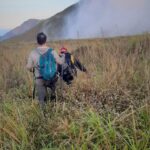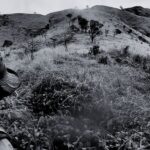EXPLORING THE WILD TERRAIN OF THE PHILIPPINES
The Philippines is a land of natural wonders, boasting lush forests, towering mountains, and pristine wilderness areas that beckon adventurers and nature enthusiasts alike. One of the best ways to experience this natural beauty is by trekking through its diverse terrain. However, those who wish to explore the Philippine wilderness must be prepared for a variety of trail surface conditions. In this article, we'll delve into the different types of trail surfaces you may encounter while trekking in the Philippines.
1. Golden Dirt
This is the best type of trail to walk on. Golden dirt is typically neither too dry nor too wet. It has just the right amount of moisture to provide traction without being overly muddy or slippery. This means that the sole of your footwear can easily bite into the soft and slightly damp (but not claggy) dirt to offer predictable traction.
You'll know you're walking on a golden dirt if you don't slip and only a small amount of dirt sticks to your footwear. This is the most enjoyable trail to walk on.
2. Muddy

The Philippines' tropical climate brings abundant rainfall, transforming dirt trails into muddy trails, especially during the rainy season. Muddy trails can be quite challenging, as they can be slippery and energy-draining. The mud can get stuck to your footwear, increasing its weight and affecting your performance. Proper footwear with good traction are a must when tackling these trails. It's also advisable to use trekking poles to maintain balance and prevent slipping.
No shoes can guarantee complete protection against slipping, regardless of any claims made by the manufacturer.
3. Loose and Dry
When the trail lacks forest cover and exposed to sunlight for a long period of time, the dirt becomes loose and dry. It's also advisable to use trekking poles to maintain balance and prevent slipping.
You'll know you're walking on a loose and dry trail if the dirt is powdery and slippery, especially when you go uphill or downhill.
4. Forest Floors

Hiking through dense forests is a common experience when exploring the Philippine wilderness. The forest floor is the most common trail surface you'll find in the wilderness and mountains in the Philippines. It may consist of compacted soil, fallen leaves, and tree roots. While this type of trail surface is generally more stable, it can still be uneven and slippery, especially after rain. Footwear with good traction are suitable for forested trails.
When you enter a forest, the forest floor is hard to miss.
5. Rocky
Many mountainous regions in the Philippines, feature rocky terrain, where you'll find uneven, jagged rocks of various sizes. These trails demand sturdy footwear that provides ankle support, as well as a keen sense of balance. Shoes with thick, grippy soles are ideal for navigating rocky paths. Take your time to carefully choose your steps to avoid injuries.
The upper part of Mount Guiting Guiting in Sibuyan Island is a classic example of a rocky path.
6. River Crossing

Numerous trails in the Philippines require hikers to cross rivers and streams. River crossings can be tricky, as the trail surface is often a combination of slippery rocks, unstable river bottom and flowing water. Using trekking poles for balance can also be immensely helpful when crossing rivers.
Crossing a raging river is one of the most dangerous parts of a wilderness journey. Its unpredictability poses a serious challenge, even for experienced individuals.
Precautions When Crossing a River
7. Volcanic Ash and Sand
In volcanic regions like Mount Mayon and Mount Pinatubo, hikers encounter trails covered with volcanic ash and sand. Walking on these surfaces can be strenuous as they tend to shift beneath your feet. Wearing gaiters can help prevent ash and sand from getting inside your boots. Hiking poles can also aid in maintaining stability on these loose surfaces.
8. Boulder
Certain mountain summits in the Philippines require trekkers to navigate boulder fields. These are large areas filled with massive rocks that can be quite challenging to traverse. Sturdy footwear with ankle support and proper balance are crucial when tackling boulder fields.
Mount Apo has boulder fields near its summit.
9. Grassland
Some Philippine mountain trails lead through high-altitude grasslands. They offer one of the best views of surrounding landscapes. These paths typically have a more stable surface compared to muddy or rocky trails. Lightweight hiking shoes or trail runners are suitable for grassy trails, but be mindful of hidden obstacles like holes or uneven ground.

High-altitude grassland somewhere between Mount Dome and Mount Iba in Zambales, Philippines.
Exploring the Philippine wilderness and mountains is a rewarding adventure, but it comes with a variety of trail surface conditions that require careful consideration. To enjoy your trek to the fullest and stay safe, it's important to choose appropriate footwear, use trekking poles for balance when necessary, and be prepared for the specific challenges posed by each type of trail surface.








